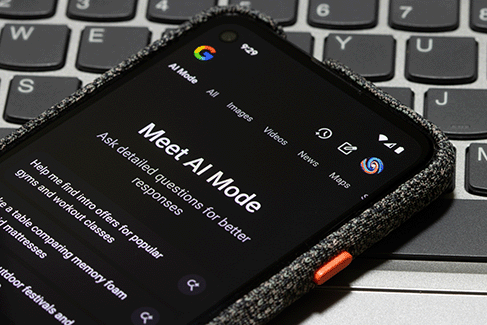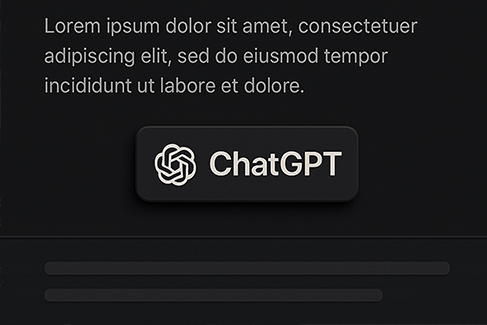How to Write FAQ Sections That Actually Get Picked Up by AI Search

Why Most AI-Generated Blog Content Doesn't Rank (And What to Do Instead)
The promise was simple: use AI to create blog content faster and cheaper than ever before. The reality has been more complicated. According to recent studies, over 73% of purely AI-generated blog content fails to achieve meaningful search rankings, leaving businesses frustrated with their content marketing investments.
But here’s what’s interesting, it’s not because Google can detect AI content. It’s because most AI-generated content fails to meet the fundamental requirements that have always determined search success. The businesses seeing results with AI content understand this distinction and have adapted their approach accordingly.
The E-E-A-T Problem: Why AI Content Lacks Credibility
Google’s E-E-A-T framework (Experience, Expertise, Authoritativeness, Trustworthiness) has become increasingly important for content ranking. According to Google’s Search Quality Evaluator Guidelines, content must demonstrate first-hand experience and genuine expertise to rank well, especially in competitive niches.
Experience: AI cannot draw from personal, first-hand experience. When a marketing agency writes about “our client’s 300% ROI increase,” that’s experience. When AI writes about generic ROI improvements, it’s not.
Expertise: While AI can access vast amounts of information, it cannot develop genuine expertise through years of practice, mistakes, and learning that human experts possess.
Authoritativeness: AI content typically lacks author bylines, credentials, and the professional recognition that establishes authoritativeness in search results.
Trustworthiness: Generic AI content often feels artificial to readers, lacking the specific details, personal anecdotes, and nuanced insights that build trust.
Research from Search Engine Journal shows that pages with strong E-E-A-T signals rank 47% higher on average than those without clear expertise indicators.
The Originality Crisis: When AI Content Becomes Background Noise
Google’s algorithms have become sophisticated at identifying and deprioritizing content that doesn’t add unique value to the search landscape. A study by Originality.ai found that 68% of AI-generated content contains significant overlaps with existing online content, creating what SEO experts call “background noise.”
The Pattern Problem AI tools trained on similar datasets often produce similar content structures, talking points, and even phrases. When thousands of websites publish AI-generated content about “digital marketing trends,” they end up competing for the same generic information space.
Missing Unique Angles Human experts naturally bring unique perspectives based on their specific industry experience, client work, and professional insights. AI content typically lacks these distinctive viewpoints that make content worth ranking.
No Fresh Data or Research Original research, case studies, and proprietary data are powerful ranking factors. AI cannot conduct studies, analyze unique datasets, or provide fresh insights that don’t already exist online.
According to SEMrush’s Content Audit, pages with unique data or original research receive 3.5x more backlinks and social shares than those without.
The Strategic Intent Gap: Missing the Mark on Search Intent
Perhaps the most critical failure of AI-generated content is its inability to truly understand and address user search intent. While AI can identify keywords, it often misses the deeper motivations and specific needs behind search queries.
Surface-Level Solutions AI content often addresses the literal keyword but misses the underlying problem. For example, someone searching “best project management software” might actually need help with team communication issues, not just software features.
Missing Context Human content creators understand industry context, seasonal factors, and current events that influence why someone might be searching. AI typically lacks this nuanced understanding.
Generic Recommendations AI tends to provide broad, generic advice that applies to everyone and no one. Effective content addresses specific situations, company sizes, or use cases.
BrightEdge research indicates that content aligned with true user intent performs 2.3x better in search rankings than keyword-focused content that misses the mark.
The Technical Structure Problem: Poor SEO Implementation
Even when AI generates decent content, it often fails at the technical SEO elements that help content rank effectively. Most AI tools don’t inherently understand how to structure content for optimal search performance.
Poor Header Structure AI often creates headers that read well but don’t follow SEO best practices for hierarchy, keyword inclusion, or user navigation.
Missing Schema Markup Structured data that helps search engines understand content context is rarely included in AI-generated content.
Weak Internal Linking AI cannot understand your existing content ecosystem to create strategic internal links that boost page authority and user experience.
Ineffective Meta Elements Title tags and meta descriptions require strategic thinking about click-through rates and keyword positioning that AI typically handles generically.
Screaming Frog’s technical SEO audit data shows that properly structured content with complete technical optimization ranks 34% higher than content without these elements.
What Actually Works: The Strategic AI Content Approach
The businesses succeeding with AI content aren’t using it as a replacement for human strategy. They’re using it as a tool within a larger strategic framework.
The Foundation-First Method
Step 1: Human Strategy Development
- Conduct keyword research with true intent analysis
- Develop content briefs based on business goals and audience needs
- Create outlines that address specific problems your audience faces
Step 2: AI-Assisted Content Creation
- Use AI to expand on human-developed outlines
- Generate first drafts based on strategic briefs
- Create variations for A/B testing different approaches
Step 3: Human Enhancement and Optimization
- Add personal experience, case studies, and unique insights
- Optimize for technical SEO requirements
- Ensure content aligns with brand voice and messaging
The Expert Review Process
Content that performs well typically goes through multiple review layers:
Subject Matter Expert Review: Ensures accuracy and adds industry-specific insights SEO Review: Optimizes for technical elements and search performance
Brand Review: Aligns with company messaging and voice User Experience Review: Confirms content serves reader needs effectively
Adding the Missing Elements
Original Research Integration Include proprietary data, client case studies, or original surveys that AI cannot replicate.
Personal Experience Injection Add specific examples, lessons learned, and professional insights that demonstrate real expertise.
Current Context Addition Reference recent industry changes, current events, or seasonal factors that affect your audience.
Technical Optimization Implement proper schema markup, internal linking strategies, and meta optimization that AI typically misses.
Industry-Specific Considerations
Different industries face unique challenges when implementing AI content strategies:
B2B Services Need detailed case studies and industry-specific expertise that AI cannot authentically provide. Success requires heavy human oversight and experience integration.
E-commerce Product descriptions and buying guides benefit from AI efficiency but need human input for unique selling propositions and customer pain points.
Healthcare and Finance YMYL (Your Money or Your Life) content requires verified expertise and cannot rely solely on AI generation due to E-E-A-T requirements.
Local Services Need geographic specificity and local market knowledge that generic AI content cannot provide effectively.
The Tools and Technologies That Bridge the Gap
Several tools and approaches help businesses create AI-assisted content that actually ranks:
Content Intelligence Platforms Tools like MarketMuse and Clearscope help identify content gaps and optimization opportunities that pure AI generation misses.
Fact-Checking and Verification Tools Services like Grammarly Business and Copyscape help ensure AI content accuracy and originality.
SEO Analysis Integration Platforms like Surfer SEO and Page Optimizer Pro provide technical optimization guidance that can be applied to AI-generated drafts.
Expert Review Workflows Project management tools that incorporate subject matter expert review processes ensure content quality before publication.
Measuring Success: What to Track
Traditional content metrics don’t always capture the full picture of AI content performance. Track these indicators:
Ranking Performance
- Average position for target keywords
- Featured snippet captures
- AI Overview citations
Engagement Quality
- Time on page and scroll depth
- Internal link clicks and page flow
- Conversion rates from content
Authority Building
- Backlink acquisition from quality sources
- Social shares and mentions
- Expert citations and references
Your Strategic Implementation Plan
Week 1: Content Audit Review existing AI-generated content for E-E-A-T gaps, originality issues, and technical problems.
Week 2: Process Development Create workflows that combine AI efficiency with human expertise and strategic oversight.
Week 3: Pilot Content Creation Test the enhanced approach with 3-5 pieces of strategically important content.
Week 4: Performance Analysis Measure results and refine the process based on what works for your specific industry and audience.
The Reality Check for Business Owners
AI content generation is a powerful tool, but it’s not a complete solution. The businesses seeing real SEO results understand that AI works best when combined with human expertise, strategic thinking, and genuine industry knowledge.
The companies that struggle with AI content are those trying to use it as a complete replacement for human-driven content strategy. The ones succeeding treat AI as a sophisticated assistant that amplifies human expertise rather than replacing it.
Your competitive advantage doesn’t come from the AI tool you choose. It comes from how strategically you integrate AI capabilities with genuine expertise and business knowledge that your competitors cannot replicate.

Ready to rank and convert with AI content?
Why Most AI-Generated Blog Content Doesn’t Rank

Why Reddit is Becoming the Secret Weapon for AI Search Visibility (And How to Do It Right)
Summarize this page with AI
The Reddit-AI Connection: Why Community Beats Corporate
Authentic User Experiences AI systems prioritize content that feels genuine and unfiltered. Reddit's comment structure, with real users sharing honest experiences and asking follow-up questions, creates exactly the kind of contextual, conversational content that AI engines value.
Comprehensive Coverage Reddit discussions often cover topics from multiple angles, with users sharing different perspectives, solutions, and experiences. This comprehensive approach gives AI engines rich material to draw from when generating responses.
Real-Time Relevance Unlike static corporate pages, Reddit discussions evolve in real-time. Users update their experiences, correct information, and provide current context that AI engines rely on for accurate responses.
Community Validation The upvote/downvote system and comment threading create a natural quality filter. Highly upvoted comments and posts signal to AI engines that the community has validated the information.
The Right Way to Build Reddit Presence
Phase 1: Listen and Learn (Weeks 1-4)
- Consistent daily activity (not dead communities)
- Questions that align with your expertise
- Community rules that allow helpful business mentions
- Engaged user bases with substantive discussions
- What types of posts get upvoted
- How community members interact
- Whether self-promotion is tolerated (and how)
- The tone and communication style that works
Phase 2: Provide Value (Weeks 5-16)
- Provide comprehensive, actionable answers
- Share specific examples and case studies
- Explain the "why" behind your recommendations
- Follow up on additional questions
- Industry trend analysis
- "Lessons learned" from your experience
- Useful tools or resources (not your own products)
- Honest takes on common misconceptions
- Upvote and comment on quality posts
- Build on others' answers with additional insights
- Create connections with regular contributors
- Participate in community discussions beyond your niche
Phase 3: Strategic Mentions (Weeks 17+)
- "I work with companies on this exact issue, and here's what I've learned..."
- "This is actually something we help clients with at [company]"
- "Feel free to reach out if you need more specific guidance"
- Link to your blog posts when they directly answer questions
- Mention your tools or services when they're the best solution
- Offer free consultations or audits when appropriate
Beyond Reddit: The Community Platform Strategy
Quora for Professional Authority
Why It Works for AI Citations:
- Question-and-answer format mirrors how AI engines process information
- Professional tone aligns with business-focused queries
- Detailed answers get indexed and referenced heavily
Strategy:
- Target industry-specific questions in your expertise area
- Provide detailed, well-researched answers
- Include relevant credentials and experience
- Link to authoritative sources and your own content when appropriate
Quora for Professional Authority
Why It Works for AI Citations:
- Professional context gives weight to business advice
- Industry-specific groups provide targeted audiences
- LinkedIn’s credibility boosts citation potential
Strategy:
- Join 3-5 active groups in your industry
- Share insights from your professional experience
- Participate in discussions about industry trends
- Build relationships with other group members
Industry-Specific Forums
Why It Works for AI Citations:
- Specialized knowledge gets highly weighted by AI engines
- Niche communities have less competition
- Deep expertise stands out more clearly
Strategy:
- Identify 2-3 forums specific to your industry
- Become a regular contributor with valuable insights
- Build reputation as a go-to expert
- Offer help without immediate promotional intent
Discord Servers for Tech Audiences
Why It Works for AI Citations:
- Real-time discussions create authentic content
- Tech-savvy users often influence broader trends
- Less corporate presence means more opportunity
Strategy:
- Join servers related to your industry or tools
- Participate in voice chats and discussions
- Share knowledge and help troubleshoot issues
- Build relationships with community leaders
The Long-Term Community Building Framework
Success in community-driven AI visibility requires consistent, strategic effort:
Month 1-2: Foundation Building
- Research and join 5-10 relevant communities
- Create consistent username and profile across platforms
- Begin participating without any promotional intent
- Document what types of content perform well
Month 3-6: Value Creation
- Establish regular posting schedule (2-3 helpful posts/week)
- Build reputation through consistent valuable contributions
- Start receiving direct messages and follow-up questions
- Begin subtle mentions of your business when relevant
Month 7-12: Strategic Scaling
- Identify which platforms generate the most engagement
- Double down on successful community strategies
- Begin cross-referencing between platforms
- Develop systematic approach to community engagement
Ongoing: Measurement and Optimization
- Track mentions in AI search results
- Monitor brand search volume increases
- Measure direct traffic from community platforms
- Adjust strategy based on what’s working
Common Mistakes That Kill Community Credibility
The Hard Sell Approach Jumping into communities with promotional content immediately marks you as spam. Communities can spot this instantly and will downvote or ban promotional accounts.
One-and-Done Participation Posting once and disappearing breaks community trust. Consistent, ongoing participation is essential for building credibility.
Generic Advice Providing surface-level advice that could come from anyone doesn’t build authority. Share specific insights from your actual experience.
Ignoring Community Rules Each platform has specific guidelines about self-promotion. Violating these rules results in immediate credibility loss.
Measuring Community Impact on AI Visibility
Track these metrics to measure your community building success:
Direct AI Citation Metrics:
- Brand mentions in AI search results for relevant keywords
- Community posts appearing in AI responses
- Increase in branded search queries
Community Engagement Metrics:
- Upvotes, likes, and positive responses to your content
- Direct messages and follow-up questions
- Invitations to participate in discussions or events
Business Impact Metrics:
- Referral traffic from community platforms
- Lead quality from community-generated contacts
- Brand awareness in target markets
The Strategic Advantage of Community-First Approach
Businesses that invest in authentic community building gain significant advantages:
Relationship Capital Real relationships with community members become powerful advocates who mention your business naturally in discussions.
Market Intelligence Direct access to customer conversations provides insights into needs, pain points, and emerging opportunities.
Content Inspiration Community questions and discussions generate endless content ideas for your owned channels.
Competitive Differentiation While competitors focus on traditional SEO, community presence creates unique positioning that’s harder to replicate.
Your 30-Day Community Building Starter Plan
Week 1: Research and Join
- Identify 5 relevant communities in your industry
- Create consistent profiles across platforms
- Begin lurking and studying community dynamics
- Make first helpful comments (no business mentions)
Week 2: First Value Contributions
- Answer 5 questions thoroughly each week
- Share one valuable insight or resource
- Engage with other helpful community members
- Continue learning community culture
Week 3: Establish Presence
- Increase to 10 helpful interactions per week
- Post your first valuable original content
- Begin building relationships with regular contributors
- Document what types of content perform well
Week 4: Optimize and Scale
- Identify most effective platforms and content types
- Create sustainable posting schedule
- Plan content calendar for following month
- Begin measuring engagement and results
The Future of Community-Driven AI Visibility
As AI search continues to evolve, community presence will become even more valuable. The businesses that start building authentic community relationships now will have significant advantages as AI engines increasingly prioritize genuine, conversational content over traditional corporate marketing.
The key is approaching community building with genuine intent to help rather than promote. When you consistently provide value to communities, both the community members and AI engines take notice.
Your community contributions become the foundation for sustainable AI search visibility that no algorithm change can eliminate.

Get Noticed by AI Through Real Community Engagement
The most successful businesses aren’t just optimizing for search. They’re building genuine communities that AI recognizes and rewards. We help brands create real connections that drive visibility, trust, and long-term growth.
How to Use Reddit for AI Search Visibility

New Study: Third-Party Content Gets Cited by AI Search 3X More Than Your Website (Here's How to Use This)
The shocking findings:
- Third-party editorial content (independent articles by journalists and industry publications about your company) receives the highest citation rates
- User-generated content from platforms like Reddit and G2 appears frequently
- Company-owned content gets significantly fewer citations than expected
- Community discussions on forums outperform traditional company blogs
This isn’t just a small preference. The data shows AI engines consistently favor content from independent sources over branded content, even when the branded content ranks higher in traditional search.
Why AI Tools Prefer Third-Party Sources
The research reveals several key reasons why AI engines cite third-party content more often:
Perceived Objectivity
AI systems appear to view third-party content as more neutral and trustworthy than content directly from the company being discussed.
Comprehensive Coverage
Review sites, forums, and editorial content often provide broader context and multiple perspectives that AI engines value for generating balanced responses.
User-Generated Validation
Platforms like Reddit, G2, and Quora contain real user experiences and discussions that AI systems consider more authentic than promotional content.
Editorial Standards
Established publications and review platforms have editorial processes that AI engines seem to recognize and favor.
The Platform-Specific Breakdown
Different AI engines show distinct preferences for third-party sources:
ChatGPT favors:
- LinkedIn articles and professional commentary
- G2 and Gartner Peer Reviews
- Industry publications and editorial content
Perplexity prefers:
- YouTube content and video demonstrations
- PeerSpot reviews and comparisons
- Technical documentation and guides
Google’s Gemini highlights:
- Medium articles and thought leadership
- Reddit discussions and community insights
- YouTube videos and educational content
What This Means for Your Business Strategy
This data suggests a strategic shift toward integrated content approach rather than abandoning your owned content entirely. The most effective strategy combines strong owned content with active third-party relationship building.
The Complete Strategy (Most Effective):
- Continue creating high-quality owned content that serves as the foundation of your expertise
- Actively earn mentions in industry publications to amplify your authority
- Generate authentic reviews on relevant platforms
- Participate in community discussions to build thought leadership
- Use owned content as the basis for third-party features and collaborations
The Old Single-Channel Approach (Less Effective):
- Focus solely on optimizing your own website pages
- Create company blog content in isolation
- Rely only on technical SEO and backlinks
Key Insights
How to Implement the Third-Party Strategy
Week 1: Audit Your Current Third-Party Presence
- Search for your company name on Reddit, Quora, and industry forums
- Check your presence on review platforms like G2, Trustpilot, or industry-specific sites
- Identify which publications cover your industry or competitors
- Note gaps where you should have presence but don’t
Week 2: Develop Your Third-Party Content Plan
- Identify 5-10 industry publications that could feature your expertise
- List relevant forums and communities where your target audience gathers
- Plan your review platform strategy (which ones matter for your industry)
- Create a content collaboration outreach list
Week 3: Start Building Third-Party Relationships
- Reach out to industry publications with expert commentary or insights
- Begin contributing valuable answers on relevant forums
- Contact satisfied customers about leaving reviews on key platforms
- Offer to provide expert quotes for journalists and bloggers
Week 4: Create Third-Party Worthy Content
- Develop case studies that publications would want to feature
- Create research or data that others would cite
- Build tools or resources that third parties would mention
- Generate thought leadership content suitable for guest publication
Platform-Specific Strategies
For Reddit and Forum Presence:
- Identify subreddits and forums where your audience asks questions
- Provide genuinely helpful answers without being promotional
- Share insights and expertise that establish credibility
- Build reputation over time through consistent valuable contributions
For Review Platform Optimization:
- Focus on platforms most relevant to your industry (G2 for SaaS, TripAdvisor for hospitality, etc.)
- Implement systematic review request processes for satisfied customers
- Respond professionally to all reviews, positive and negative
- Use review insights to improve products and services
For Industry Publication Features:
- Develop unique research, surveys, or industry insights
- Offer expert commentary on trending industry topics
- Create newsworthy content that publications want to cover
- Build relationships with journalists and editors in your space
For YouTube and Video Content:
- Create educational content that others would reference
- Participate in industry discussions and panels
- Share expertise through video format that AI engines favor
- Collaborate with other creators in your industry
Measuring Third-Party Success
Track these metrics to measure your third-party strategy effectiveness:
Direct Metrics:
- Mentions in AI search results for your target keywords
- Volume of third-party mentions and citations
- Review platform ratings and review volume
- Forum and community engagement metrics
Indirect Metrics:
- Brand search volume increases
- Direct traffic from third-party sources
- Lead quality from third-party referrals
- Overall brand awareness metrics
AI Visibility Tracking:
- Monitor your brand mentions in AI responses using tools like ChatGPT, Perplexity, and Gemini
- Track which third-party sources most often mention your brand
- Identify which topics generate the most third-party coverage
Common Mistakes to Avoid
Being Too Promotional
Third-party sources won’t mention you if your contributions are obviously self-promotional. Focus on providing genuine value first.
Ignoring Negative Mentions
Monitor all third-party mentions, not just positive ones. Address concerns professionally and transparently.
Expecting Immediate Results
Building third-party presence takes time. Focus on relationship building and consistent value delivery.
Only Focusing on High-Authority Sites
Mid-tier sources also get cited by AI. Don’t ignore smaller but relevant industry publications and communities.
The Long-Term Strategic Shift
This research suggests we’re entering an era where earned media becomes more valuable than owned media for AI visibility. Businesses that understand this shift early will have significant advantages.
Key strategic changes:
- Content teams should focus on creating resources that others want to cite and reference
- PR efforts should target AI-friendly platforms and publications
- SEO strategies should include third-party mention tracking and optimization
- Brand building should prioritize community engagement and thought leadership
Your 30-Day Third-Party Action Plan
Week 1: Audit current third-party presence and identify gaps
Week 2: Develop outreach lists and content collaboration strategy
Week 3: Begin outreach and community engagement
Week 4: Launch review platform optimization and content creation
Ongoing: Monitor AI search results for your brand mentions and adjust strategy based on which third-party sources most often cite your business.
The Bottom Line for Business Owners
The companies dominating AI search results aren’t necessarily the ones with the best websites. They’re the ones being talked about, reviewed, and referenced by third parties across the web.
This shift rewards businesses that genuinely serve their customers and communities over those that simply optimize their own content. It’s a return to fundamental business principles: provide value, build relationships, and earn recognition through merit.

Want to develop a comprehensive visibility strategy?
Summarize this page with AI
How to Use Third-Party Content to Show Up AI Search Result 3X More

The Social Sharing Button Trick That's Getting Websites Featured in AI Search Results
How AI-Focused Sharing Buttons Actually Work
How it looks:
The Strategic Opportunity (And Why It Matters Now)
Brand Visibility: Your domain name appears in AI responses, building recognition even when users don't click through
Authority Building: Being cited by AI tools positions your content as a trusted source
Future Discoverability: Users who have interacted with your content through AI may be more likely to see it referenced again
Competitive Advantage: Most businesses aren't doing this yet, giving early adopters a visibility edge
Three Ways to Implement This Strategy
1. The Transparent Approach (Recommended)
Create clearly labeled buttons that tell users exactly what they do:
- “Summarize this article with ChatGPT”
- “Get AI insights on this content”
- “Analyze this with Claude”
Why this works: Users know what to expect, creating a positive experience that encourages repeat use.
2. The Value-Added Approach
Design buttons that offer specific utility:
- “Adapt this recipe with AI” (for food blogs)
- “Get personalized financial advice” (for finance content)
- “Create a custom workout plan” (for fitness sites)
Why this works: Users get immediate value while your content gets integrated into their AI workflow.
3. The Content Enhancement Approach
Add buttons at strategic points in your content:
- After complex explanations: “Simplify this with AI”
- Before step-by-step processes: “Get personalized steps”
- At the end of comprehensive guides: “Create your action plan”
Real-World Implementation Examples
For Service Businesses:
“Get AI recommendations based on this guide”
“Create a custom checklist for your situation”
“Analyze how this applies to your business”
For E-commerce:
“Find similar products with AI”
“Get personalized product recommendations”
“Compare options for your specific needs”
For Content Publishers:
“Get key takeaways from this article”
“Create study notes from this content”
“Generate discussion questions”
How to Add “Summarize with ChatGPT” or other AI Buttons
Here’s a simple example you can copy and paste into your page or post:
<a href="https://chat.openai.com/?q=Summarize+the+content+at+https://yoursite.com/this-page" target="_blank" style="...style here...">
📝 Summarize with ChatGPT
</a>
<a href="https://gemini.google.com/app?q=Summarize+the+content+at+https://yoursite.com/this-page" target="_blank" style="...style here...">
🔍 Summarize with Gemini
</a>
<a href="https://claude.ai/chat?prompt=Summarize+the+content+at+https://yoursite.com/this-page" target="_blank" style="...style here...">
🧠 Summarize with Claude
</a>
WordPress Users: Want a Plugin Instead? If you’re using WordPress, several plugins can automate this process and offer more features like:
- Custom prompts (“Turn this article into bullet points”)
- Support for multiple AI tools
- Analytics or click tracking
Search for “AI share buttons” in the plugin marketplace to explore your options, or build your own with a custom block if you’re using Gutenberg.
What About User Experience and Ethics?
The key to success with AI sharing buttons is transparency and genuine value:
Good Practice:
- Clearly label what the button does
- Provide real value to the user
- Place buttons where they make contextual sense
Avoid:
- Hidden prompts that do more than advertised
- Buttons that feel pushy or manipulative
- Overwhelming users with too many AI options
Measuring Success and ROI
While direct attribution can be challenging, track these indicators:
Engagement Metrics:
- Click-through rates on AI sharing buttons
- Time spent on pages with AI buttons
- Return visitor rates from users who’ve used AI buttons
Visibility Indicators:
- Mentions of your domain in AI conversations (when users share results)
- Increased brand searches following AI button usage
- Growth in direct traffic from users familiar with your content
Content Performance:
- Pages with AI buttons may see improved traditional SEO performance
- Increased social shares of AI-generated summaries
- Higher engagement on follow-up content
Platform-Specific Strategies
ChatGPT Integration
Best for comprehensive content that benefits from summarization or analysis.
Claude Integration
Effective for technical or detailed content that requires thoughtful interpretation.
Perplexity Integration
Ideal for research-heavy content that users might want to fact-check or expand upon.
Implementation Best Practices
Start Small and Test
Add AI buttons to your top 5 performing pieces of content
Test different button text and placement
Monitor user behavior and feedback
Focus on User Value
Choose prompts that genuinely help your audience
Consider what users would actually want to do with your content
Make the AI interaction useful, not just promotional
Maintain Content Quality
AI tools will only cite and recommend quality content
Ensure your content is comprehensive and accurate
Keep information up-to-date and relevant
The Bigger Picture: Preparing for AI-First Discovery
This sharing button strategy is part of a larger shift toward AI-powered content discovery. Businesses that understand and adapt to this trend will have significant advantages as AI tools become primary information sources.
Key preparation steps:
- Audit your content for AI-friendliness (clear structure, comprehensive information)
- Identify high-value content that would benefit from AI integration
- Test AI sharing buttons on select pieces to gauge user response
Monitor AI tool developments to stay current with new opportunities
Your Next Steps
This week: Choose one high-performing piece of content and add a simple “Summarize with ChatGPT” button. Use clear, honest language about what the button does.
This month: Expand to 5-10 key content pieces, testing different button text and placement strategies.
This quarter: Develop a comprehensive AI visibility strategy that includes optimized content structure, strategic AI button placement, and performance tracking.
The businesses winning in AI search aren’t necessarily the ones with the most advanced technology. They’re the ones making it easy for users to discover and interact with their content through AI tools.
Want to get featured more often in AI search results? This type of forward-thinking digital strategy is exactly what we help businesses implement. From content optimization to cutting-edge visibility tactics, we stay ahead of the trends so you can focus on growing your business.
Summarize this page with AI
How to Get Featured in AI Search Results with Sharing Buttons

How Businesses Can Win at Blogging in Google's AI Era (Even With Limited Resources)
The reality is that AI Overviews now appear in over 13% of all searches and that number is climbing fast. But here's the thing most businesses are missing: this isn't about replacing your current strategy. It's about making your existing content work harder.
The Truth About AI Overviews and Small Business Opportunity
AI Overviews still rely heavily on traditional organic rankings. Google uses existing top-ranking content as the foundation for AI-generated responses. This means your SEO fundamentals still matter; they're just being presented in a new format.
Small businesses have a personalization advantage. AI systems love content that directly answers specific questions for specific audiences. Your local market knowledge and niche expertise are exactly what AI Overviews want to feature.
Interactive and structured content performs exceptionally well. Small businesses can create this type of content faster and more authentically than large corporations.
The Content Formats That Get Featured in AI Overviews
- Question-and-Answer Structured Content
Instead of writing general blog posts, structure your content to directly answer specific questions your customers ask.
Instead of: “Marketing Strategies for Small Businesses” Try: “Should My Small Business Use Google Ads or Facebook Ads First?” - Step-by-Step Process Guides
AI loves clear, actionable processes that it can summarize for users.
Example: “The 5-Step Process to Choose the Right Contractor for Your Home Renovation” - Interactive Tools and Checklists
This is where small businesses can really shine. Interactive content gets featured and drives engagement.
Real Example: How Interactive Content Dominates AI Search
The Strategy: Creating an "Interactive Assessment Tool" that works like this:
- Short, guided quiz with yes/no questions about specific challenges
- Personalized results like: “Based on your answers, you may benefit from X solution. Here’s what to do next…”
- Supporting blog content that explains each step of the process
- High user engagement because visitors get immediate, personalized value
- Perfect for AI Overviews because it’s structured, educational, and specific
- Demonstrates expertise while guiding the next step in the customer’s journey
- Generates qualified leads through downloadable resources and consultation forms
Your Small Business Blogging Strategy for the AI Era
Week 1: Audit Your Existing Content
- Does this directly answer a specific question?
- Is the information structured clearly with headers and bullet points?
- Could someone scan this in 30 seconds and get value?
Week 2: Identify Your "Interactive Content" Opportunity
- Checklists (like our IEP example)
- Calculators (mortgage, ROI, savings, etc.)
- Assessment tools (readiness quizzes, compatibility checks)
- Decision trees (which service/product is right for me?)
- HVAC: “Is Your System Ready for Winter?” checklist
- Financial Services: “Should You Refinance?” calculator
- Marketing Agencies: “Is Your Website Converting?” assessment
- Restaurants: “Which Catering Package Fits Your Event?” quiz
Week 3: Create Your First AI-Optimized Blog Post
- Headline: Direct question your customers ask
- Quick answer: 2-3 sentence summary at the top
- Detailed sections: Each addressing a related question
- Interactive element: Checklist, calculator, or assessment
- Next steps: Clear call-to-action based on their situation
Free Download: AI-Optimized Blog Post Checklist
Week 4: Optimize for Local and Niche Visibility
Create content like:
- “Common [Your Service] Problems in [Your City]”
- “[Industry] Trends That Actually Matter to [Specific Audience]”
- “Why [Your City] Businesses Choose [Your Solution]”
The Technical Details That Matter (But Don't Overthink)
- Clear, descriptive headers
- Logical content structure
- Fast-loading pages
- Mobile-friendly design
- FAQ sections within longer posts
- Numbered or bulleted lists for key points
- Clear "summary" sections
- Schema markup for structured data
What to Track and Measure
- Organic traffic
- Time on page
- Conversion rates
- AI Overview appearances (use Google Search Console to track impressions)
- Engagement with interactive elements (tool usage, quiz completions)
- Question-based keyword rankings (how-to, what is, should I, etc.)
The Biggest Mistake Small Businesses Make
Large companies publish dozens of generic posts. Small businesses win by creating fewer, more valuable pieces that directly solve specific problems for specific audiences.
Instead of: 20 generic "tips" posts Create: 5 comprehensive, interactive pieces that become the definitive resource for your niche
Your Action Plan for This Month
- Convert your most popular blog post into an interactive tool or comprehensive guide
- Create a “decision tree” blog post that helps customers choose between your services
- Build a local resource hub that answers every question about your service in your area
- Develop an assessment tool that qualifies leads while providing immediate value
The Bottom Line for Small Businesses
While your competitors are worried about AI taking over, you can be the business that gets featured because you actually solve problems better than anyone else.
The companies thriving in AI search aren't necessarily the biggest or most technical. They're the ones creating content so valuable that AI systems want to feature it.
Your advantage as a small business: You know your customers' real problems, you can move quickly, and you can create personalized solutions that large companies can't match.
Start with one piece of interactive, problem-solving content. Make it genuinely useful. Then build from there.

Ready for Content That Shows Up in AI Search Results?
Summarize this page with AI
How Small Businesses Can Win at Blogging in Google’s AI Era (Even With Limited Resources)

Why Google's AI Mode Changes 91% of Search Results Every Time (And What This Means for Your Business)
The Study That Changes Everything
Watch the full study breakdown:
- Only 9.2% URL overlap between repeat searches for identical queries
- 14% of AI Mode citations match the top 10 traditional search results
- 21.9% domain-level overlap when looking at entire websites rather than specific pages
- 17.9% of queries show zero overlap with traditional organic results
What Makes AI Mode Different from Regular Google Search
- Pulls from an average of 12.6 citations per response
- Uses primarily block links (90.8% of citations)
- Operates independently from Google’s traditional ranking algorithms
- Refreshes its source selection continuously
How do you know?
5.7%
94.3%
Why This Volatility Actually Creates Opportunity
- The Playing Field Just Got Bigger
Traditional search results were dominated by a small group of top-ranking pages. AI Mode draws from a much wider pool, giving quality content more chances to be featured—even if it doesn’t rank in the top 10. - Fresh Content Gets More Chances
Since AI Mode constantly refreshes its citations, newer content has better opportunities to gain exposure compared to the entrenched top results in traditional search. - Expertise Matters More Than Authority
The study showed that niche, highly relevant content often gets cited over generic, high-authority pages. This benefits businesses with deep expertise in specific areas.
How Smart Businesses Are Adapting
Focus on Comprehensive Topic Coverage
Instead of targeting individual keywords, successful companies are creating content that covers entire topics comprehensively. AI Mode tends to cite sources that thoroughly address related questions within a single piece.Prioritize Domain-Wide Authority
Since AI Mode pulls from various pages across your domain, building overall site authority becomes more important than optimizing individual pages for specific keywords.Create Answer-Focused Content
AI Mode excels at finding direct answers to specific questions. Content structured as clear, actionable answers gets cited more frequently than general informational content.Monitor AI Citations, Not Just Rankings
Traditional ranking positions matter less in AI Mode. Smart businesses are tracking mentions and citations across AI responses rather than focusing solely on SERP positions.
The Immediate Action Plan for Your Business
- Audit your content for comprehensiveness—identify topic gaps where you could provide more thorough coverage
- Review your FAQ sections—AI Mode frequently cites direct answers to specific questions
- Check your technical SEO—while rankings matter less, crawlability and site structure still impact AI discovery
- Expand existing high-performing content to cover related subtopics and questions
- Create topic cluster content that demonstrates expertise across your entire service area
- Start tracking AI mentions using tools that monitor citations across AI responses
- Develop a content strategy focused on becoming the definitive source for your niche topics
- Build domain authority through consistent, expert-level content publication
- Optimize for AI discoverability with clear structure and comprehensive coverage
What This Means for Different Types of Businesses
Service Businesses: How-to guides, process explanations, and industry insights are getting more visibility in AI Mode than traditional SEO might suggest.
B2B Companies: Technical expertise and detailed explanations of complex topics are performing exceptionally well in AI citations.
The Reality Check
- Tracking performance becomes more complex
- Traditional SEO metrics need supplementation
- Content strategy requires more comprehensive planning
- Results take longer to predict and measure
Looking Forward: What to Expect
The companies thriving in this new environment aren't trying to game the system, they're becoming genuinely better resources for their audiences. They're creating the kind of comprehensive, expert content that AI systems naturally want to cite.
Your Next Move
Start by auditing one piece of your top-performing content. Can you expand it to answer related questions? Can you add expert insights that make it more comprehensive? Can you structure it to better serve as a definitive resource?
That's where your AI Mode strategy begins.




